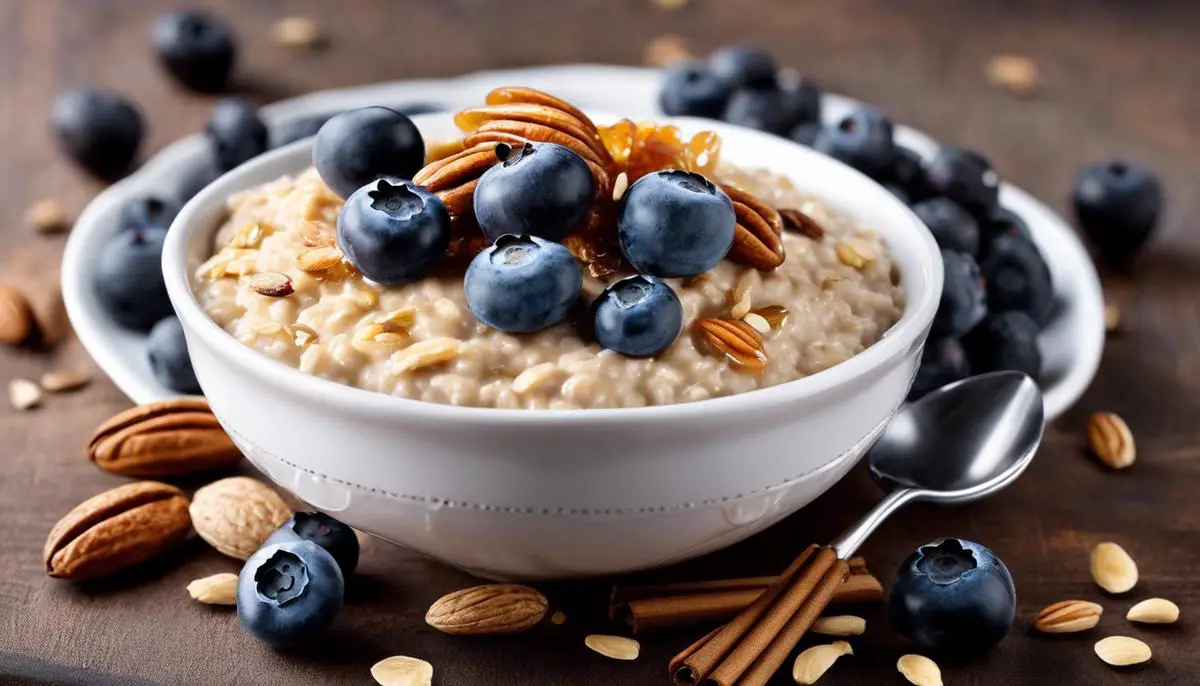Oatmeal, a cozy and comforting dish, is often celebrated for its wholesome simplicity and malleable flavor profile. But beyond its warm spoonfuls lies a tapestry of nutritional nuances that beckon for a closer look. From steaming bowls of traditional rolled oats to the quick and convenient instant varieties, the caloric and nutritional landscape of oatmeal is as varied as it is rich. This exploration serves to peel back the layers of oatmeal’s energizing essence, examining the factors that define its caloric content and unveiling the multitude of health benefits tucked within its fibrous embrace.
Table of Contents
Caloric Content of Oatmeal
How Many Calories in a Bowl of Oatmeal? A Comprehensive Nutritional Breakdown
How many calories are in a bowl of oatmeal? For health-conscious individuals and those keeping an eye on their calorie consumption, understanding the caloric value of oatmeal is essential to maintaining a balanced diet. Oatmeal, a staple breakfast food, is considered a nutritious whole grain offering sustainable energy. This article will examine the calorie content of a typical serving of oatmeal and discuss its nutritional components, ensuring readers can appreciate both its energy provision and its role within a nutritious diet.
Caloric Content of Standard Oatmeal Serving
A standard bowl of cooked oatmeal, which is approximately one cup (234 grams), can contain around 158 calories. The exact calorie count can depend on the type of oats used—such as steel-cut, rolled, or instant—and whether any additional ingredients like milk, sugar, fruits, or nuts are added. Plain oatmeal is a low-calorie option that is high in fiber and can be part of weight management and heart-healthy diets.
Key Points:
- Standard bowl (1 cup/234g): Roughly 158 calories
- Plain oatmeal is low in calories but high in fiber, aiding in fullness and digestion
- Caloric value can change with the addition of ingredients like fruit, nuts, or sweeteners
Nutritional Significance of Oatmeal
Oatmeal stands out not only for its calorie content but also for its nutritional profile. It provides a significant amount of dietary fiber, around 4 grams per cup, which is vital for digestive health and may aid in lowering cholesterol levels. Oatmeal is also a good source of protein, offering about 6 grams per serving that contributes to repair and growth in the body. Additionally, it contains essential vitamins and minerals, such as iron, magnesium, and zinc, which play crucial roles in overall health maintenance.
Calories with Common Additions
Enhancing oatmeal with various toppings can affect not just the taste but also the caloric intake. For instance:
- Adding a tablespoon of honey or sugar adds about 64 calories.
- Mixing in a 1/2 cup of fresh blueberries contributes approximately 42 calories.
- A 1/4 cup of chopped nuts can add around 200 calories, depending on the type.
While these additions can elevate the calorie count, they can also boost the oatmeal’s nutritional value, introducing antioxidants, healthy fats, or additional fiber. It’s essential to balance the desire for flavor with an awareness of caloric and nutritional changes brought on by these extras.
Oatmeal’s versatility and nutrient density make it a valuable dish for those looking to maintain a healthful diet while managing caloric intake. Whether enjoying a simple bowl of plain oatmeal or dressing it up with flavorful toppings, oatmeal offers a solid foundation for a nourishing start to the day.

Nutritional Benefits of Oatmeal
Health Benefits of Oatmeal: Heart Health and Blood Sugar Control
Oatmeal’s benefits transcend beyond its respectable nutritional profile. It plays a pivotal role in bolstering heart health and managing blood sugar levels. Rich in beta-glucan, a type of soluble fiber, oatmeal is adept at lowering LDL cholesterol, commonly known as the ‘bad’ cholesterol. This soluble fiber forms a gel-like substance within the digestive tract, which binds to cholesterol-rich bile acids, aiding in their excretion. Consistent oatmeal consumption may, therefore, contribute to a reduced risk of coronary heart disease.
The impact of oatmeal on blood glucose levels is another remarkable benefit. The low glycemic index (GI) of oatmeal signifies a more gradual rise in blood sugar post-consumption, making it a wise choice for individuals with insulin resistance or type 2 diabetes. By fostering a steady blood sugar level, oatmeal aids in maintaining energy levels and preventing the spikes and crashes associated with higher GI foods. This glycemic management is crucial for long-term metabolic health and weight control.
Oatmeal and Digestive Well-being
The advantages of oatmeal extend to digestive health, predominantly due to its high fiber content. The fiber in oatmeal helps normalize bowel movements, potentially preventing constipation. The presence of both soluble and insoluble fiber caters to an efficient digestive process; insoluble fiber adds bulk to stool, facilitating smoother passage, while soluble fiber may protect against gastrointestinal disorders. This duality makes oatmeal a pivotal inclusion in diets targeting digestive equilibrium.
Furthermore, routine oatmeal intake has been associated with a satiating effect, which can curb the urge to indulge in less healthful snacks between meals. This attribute renders oatmeal a strategic ally for those embarking on a journey toward weight management or maintenance. It’s a wholesome vessel, not just for its innate nutritional merits but also for its role in fostering a healthy gut – an often-underrated protagonist in overall well-being.
By integrating oatmeal into one’s daily diet, individuals embrace a food that not only nourishes but also defends against a myriad of health concerns, advocating for systemic harmony and wellness.

The journey through oatmeal’s caloric complexity and nutrient density brings to light a food that is much more than a breakfast staple; it stands as a testament to the synergy between health and taste. The oat grain’s adaptability, not only in preparation but also in nutritional contribution, reinforces its role as an invaluable protagonist in the narrative of a balanced diet. As we consider the implications of our food choices, oatmeal emerges as a delightful ally, harmonizing our desire for flavorful sustenance with our quest for a nourished life.

Tamara Tanasković Specialist Professional Nutritionist-Dietitian Expert in Public Health Nutrition
As an authoritative source in nutrition and dietetics, my website serves as a comprehensive educational platform. It offers in-depth insights into nutrition, covering diverse areas like dietetics, food technology, and specific nutritional needs during different life stages such as childhood, adolescence, pregnancy, and lactation. Additionally, I provide evidence-based clarifications on prevalent nutrition myths.
Visitors to the site can benefit from my expertise as a specialist professional nutritionist-dietitian through personal consultations or tailored nutrition plans designed to meet individual health goals.
Biography
Tamara Tanasković’s professional journey began with a foundational education at the Pharmaceutical-Physiotherapeutic School, where she specialized as a cosmetic technician and a physiotherapy technician. This multidisciplinary background laid the groundwork for her focused studies in nutrition and dietetics at the Higher School of Health Studies in Belgrade. Her advanced academic achievements earned her the title of a specialist nutritionist-dietitian, with a particular emphasis on public health.
I am the creator of the influential Instagram page @planishrane, dedicated to spreading knowledge about healthy eating habits, the importance of lifestyle choices, and the interplay between diet and various health conditions. My experience extends over several years in crafting personalized online meal plans, catering to both wellness-focused individuals and those with specific health conditions.
In collaboration with cosmetician Jelena Vještica, I co-authored four handbooks in January 2021. These guides delve into the relationship between diet and skin health, specifically addressing facial care and nutritional approaches to managing acne and related skin conditions.
My work and the impact of my website have garnered recognition from renowned entities like Prolom Water, Prolom Spa, Lukovska Spa, Just Superior, Jumbo, ABC, Fun&Fit, Piazza Organica, and more.
In line with my commitment to holistic health, I engage in the cultivation of organic herbs, vegetables, and fruits. My mission is to empower individuals with the knowledge and tools to make informed health choices throughout their lives, fostering a culture of wellness and informed dietary practices.
Embracing Healthy Eating for a Healthier Life!





